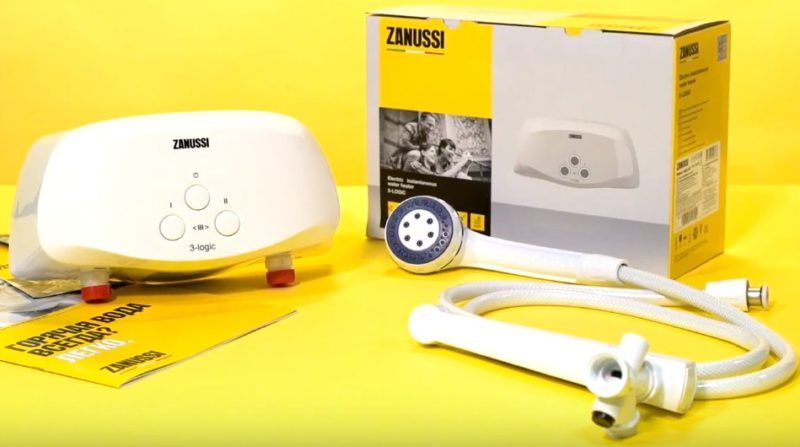Choosing a home slicer: ranking of the best in 2020
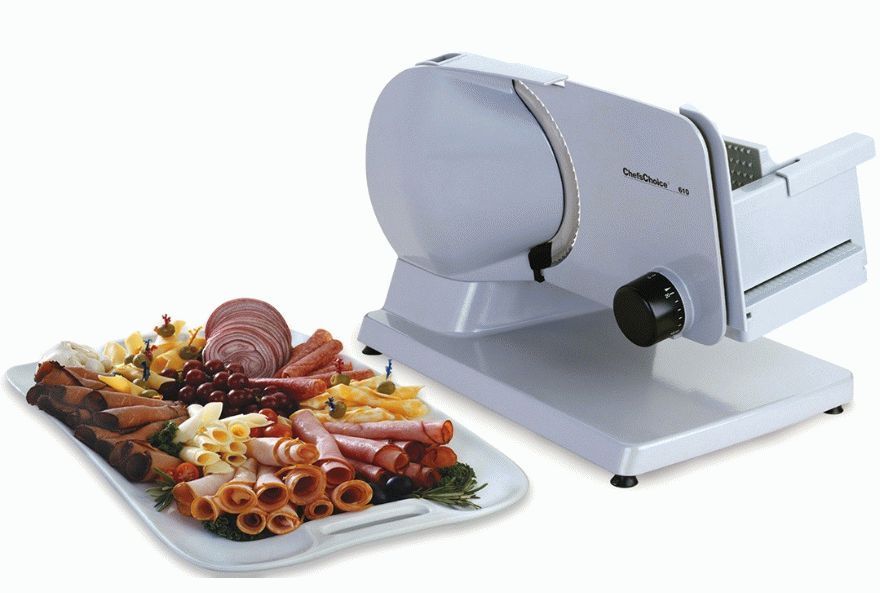
When we come to a cafe or restaurant and order cuts, fish or meat, they bring us beautifully decorated dishes with perfectly even slices of food. But we rarely visit such places by the company, and, as a rule, we celebrate holidays and birthdays at home in a cozy family atmosphere. And any hostess wants the laid table to look no worse than the restaurant table with a thin original cut.
Therefore, sooner or later, many women face the problem of buying a slicer. How to choose this device, which company is worth buying a slicer, we will tell you in our rating of the best slicers for the home.
What is a slicer and what they are
In order to understand which model is better to buy for home use, you need to figure out what slicers are, and what kind of functionality they have.
A slicer is a small household appliance designed for cutting various products into plates of the same thickness. Otherwise, it is called a slicer, from the English word slice - a slice, a slice. It is used for cutting sausages, cheese, mushrooms, vegetables and fruits. It is not recommended to cut meat products and vegetables that have bones or are very hard in their composition (such as turnips).
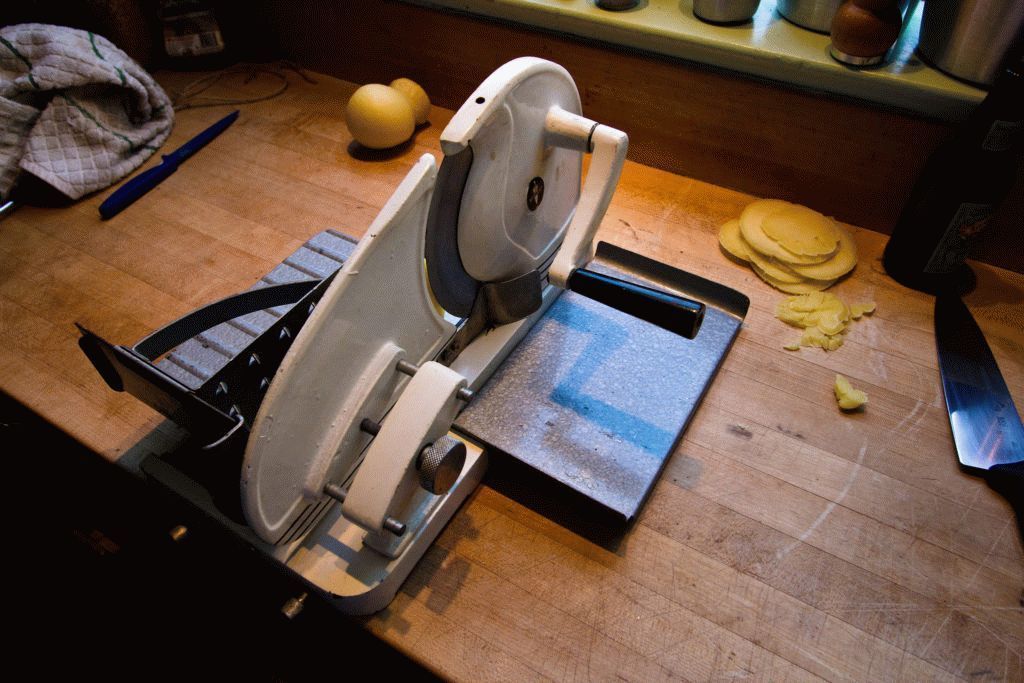
There are the following types of slicers:
- manual, which, in turn, are divided into devices that simulate a slicer, and mechanical;
- electrical.
Manual slicers, advantages and features of use
Considering manual slicers as a constant use device for creating fantastic slices is not worth it. They are designed for more rare use, when you need to quickly cut any one product. It won't turn out very smoothly. But there will be no need to disassemble and wash a complex structure.
Slicer Sliser
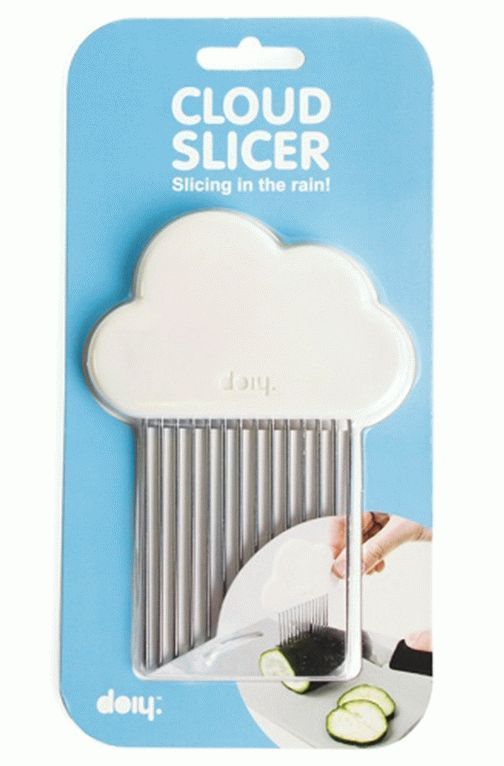
Slicer device
This device will help you cut vegetables (cucumbers, potatoes, zucchini) into thin slices without much difficulty. She is always at hand and helps to make food more aesthetic.
- small;
- easy to use and wash.
- only small vegetables can be cut;
- the slices are not very even;
- not suitable for cutting large quantities of food.
Slicer "Snap-n-Slice"
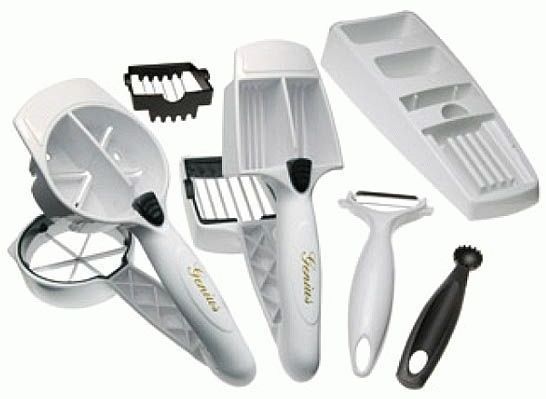
This small device is a serious assistant in the kitchen. It can be used to quickly cut boiled potatoes, carrots, boiled eggs, tomatoes, cucumbers, mushrooms and cheese. The very sharp blades do not crush food and prevent juice from escaping, for example from tomatoes.
- compactness;
- easy to disassemble and wash;
- ease of use.
- you cannot cut sausages, bread;
- impossible to cut into the finest slices;
- easy to get hurt.
Slicer STATUS 115010
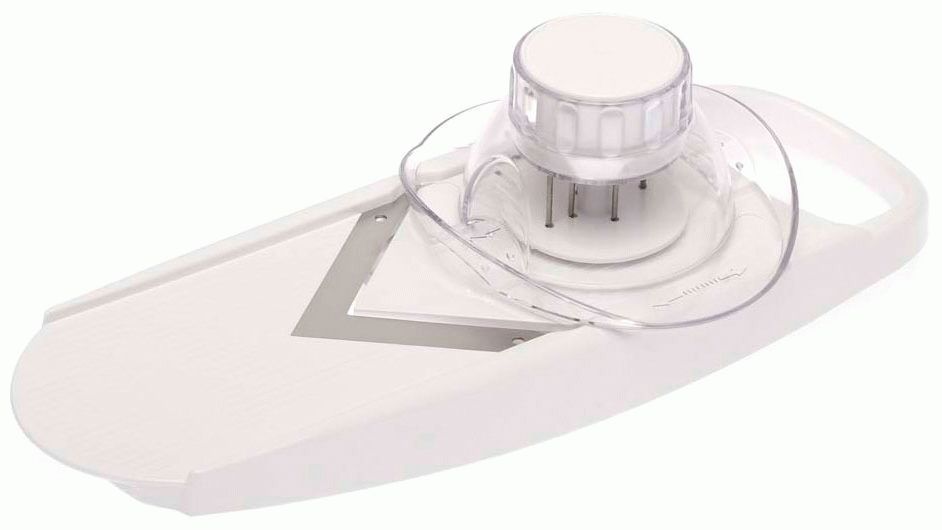
This handheld slicer is suitable for slicing vegetables, fruits, durum breads, various types of cheese products as well as cold cuts. The sharp V-shaped knife and product holding device help you cut quickly and thinly.
- very thin slices are obtained;
- easy to use.
- maximum slice thickness 6 mm;
- easy to cut yourself;
- not suitable for large amounts of slicing.
Mechanical slicers
The inconvenience of using mechanical hand-held devices, the appearance of inexpensive electrical analogs and other hand-held devices, made this type of slicer completely unclaimed. Therefore, these models leave the market for small household appliances and are not considered in our rating.
Electric slicers: what are they and their features
To choose the right electric slicer, you need to know what characteristics they have.
Selection factors
- Decide on the location of the device. If you have somewhere to put the device in a permanent place, then it is better to purchase a slicer of a solid design. It will cost a little less and will last much longer. In the case when there is little space in the kitchen and you have to remove the device, you should buy a folding structure. It will be more expensive, and the strength and durability is inferior to the whole one.
- Pay attention to the power of the device. On sale, most often there are devices with a power of 80 to 200 watts. For home use, a slicer with an indicator of 100 watts is enough. And the more powerful ones are used at a professional level and you will not feel a big difference when using it in your kitchen.
- A significant characteristic will be the material of the product body. They come in plastic and metal. Most often, plastic appliances are used in everyday life, they are cheaper, and material flaws, such as the appearance of scratches and low strength, are not felt at all when used at home. Metal slicers are more expensive and are made primarily for use in food processing facilities. When buying a plastic slicer, make sure the material is strong and doesn't flex. Otherwise, there is a risk that the body of the device will burst when pressed strongly.
- The main part of the slicer is the knife. Therefore, the best manufacturers of popular models install Solingen knives in their appliances. They can be steel or ceramic. There are also devices where the knives are coated with ceramics. You should only buy a slicer with self-sharpening knives.
Types of sharpening:
- Straight. A relatively inexpensive type of sharpening, designed mainly for homogeneous products such as sausage or cheese. Cuts bread and vegetables poorly.
- Wavy. More expensive, but easy to cut through all kinds of products thanks to the small serrations on the wavy edge of the blade. This option stays sharp for a longer time than straight knives.
- Toothed. Sharp prongs are easy to tackle heterogeneous products, but the cost is high.
Knife diameter:
Depending on the diameter of the blade, the slicer can be used to cut products of various sizes. For small products, blades with a diameter of up to 230 mm are used, and large ones from 230 to 300 mm.
In most models of slicers, the thickness of the slices can be changed depending on the required size. For household slicers, it is adjustable in the range from 1 to 17 mm, and in professional slicers - from 0.5 to 23 mm. There are devices for which the recommended thickness for various products is indicated in the instructions, for example, sausage can be cut into slices of 2-3 mm, cheese - 3-4 mm, and bread - 11 mm.
Slicer functions
Different models of slicers have their own set of functions, depending on which they differ and in price.
- The ability to adjust the cutting speed. The quality of the resulting slices depends on this function.The high speed cuts hard foods such as vegetables and smoked sausages, while the low speed cuts soft bread or tomatoes. All professional devices are equipped with this function.
- Pulse mode. Changing the slices at high speed with short pauses helps to better cut dense, non-uniform products, as well as large volumes that require slicing. This function prevents knives from breaking.
- Blocking. Child protection consists in the presence of a two-button switching system, which must be pressed simultaneously. Pressing with a little effort can only be made by an adult.
- Possibility to adjust the tilt. Some models of slicers can be tilted from 10 to 15 degrees for more convenient work with the device. This function is not found in all types of slicers.
What can be included in the set of slicers
When buying a device, you can pay attention to additional "chips" that will be useful when using it.
- Space for the power cable. Some slicers have a special compartment in which the power cord is wound. It turns out to be smooth, without creases, which will ensure its durability.
- Slicing tray. A very handy device that collects all the resulting finished cuts. It can be built-in and removable. The second type of pallet is more practical to use.
- Protective case. It is necessary to protect the knives from external influences and from accidental injury to users of the slicer.
- Knives. Availability of different straight and wavy knives. This will help save the more expensive blade by not using it for simple cuts. Some models are equipped with special knives for specific types of food, such as cheese, smoked meats and fruits.
- Nozzles. Various attachments are used for cutting food into slices or strips. As a rule, 1-2 nozzles are always used in the course.
- Feet with rubber base. Rubberized feet make the device more stable, prevent tipping over and prevent slipping, which reduces the risk of injury.
Important! Look at the carriage. It should simply slide on the surface, and be sure to have a special palm rest with thumb protection. The carriage nudger should be spiked to securely fix the cut product.
Rating of the highest quality slicers
Our rating considers the most popular models for home use available at a price to any segment of the population.
Gorenje R506E
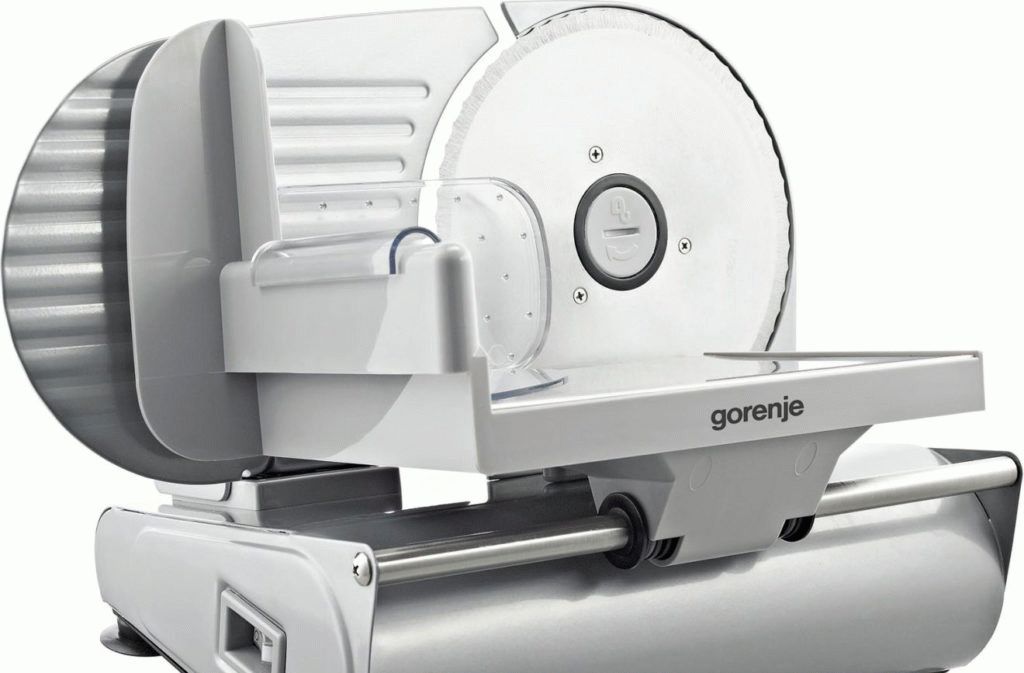
The pleasant silver color of the metal body with an inclined surface gives the impression that you are using a professional device. Convenient to use with an average price of 5500 rubles. This model will make your dream to decorate your table beautifully a reality.
- Metal body;
- tiltable work surface;
- child lock;
- rubberized feet.
- no tray for ready-made slices;
- lack of a knife removal device.
Bomann MA 451 CB
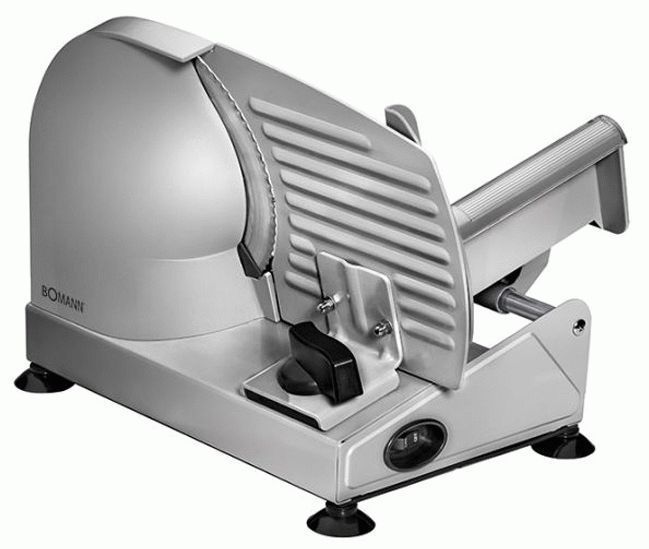
The no-nonsense principle is at the heart of this slicer. Low price in the region of 5500 rubles, the maximum thickness of the pieces is 15 mm, the power of the device is 150W. It cuts well all types of food without breaking the ends.
- affordable price;
- metal body;
- ease of use.
- difficult to adjust the thickness of the pieces;
- the holder cannot grip small products.
Bosch MAS 9454 M
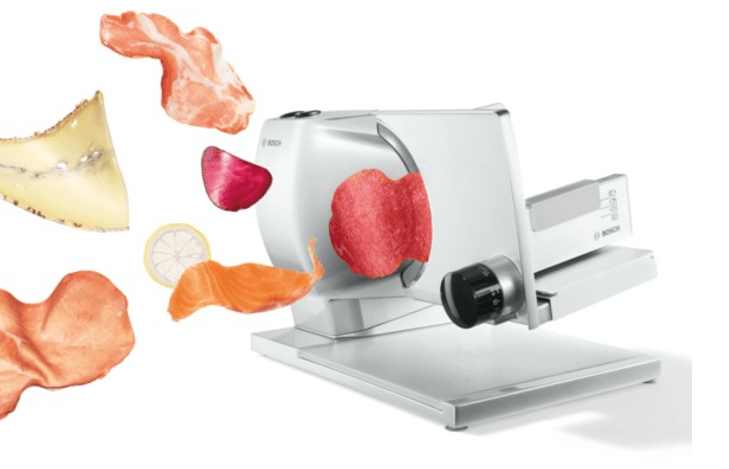
Lamer Bosch MAS 9454
It is a stylish and functional slicer with 140W power and wave knife. There is a pulse mode, slicing thickness up to 15 mm, built-in tray for slices, tilt of the working surface up to 10 degrees. The feet of the appliance are equipped with suction cups for a more stable position. The average price is 11,000 rubles.
- unusual design;
- many functions;
- metal case.
- high price;
- takes up a lot of space.
Bosch MAS 4601N
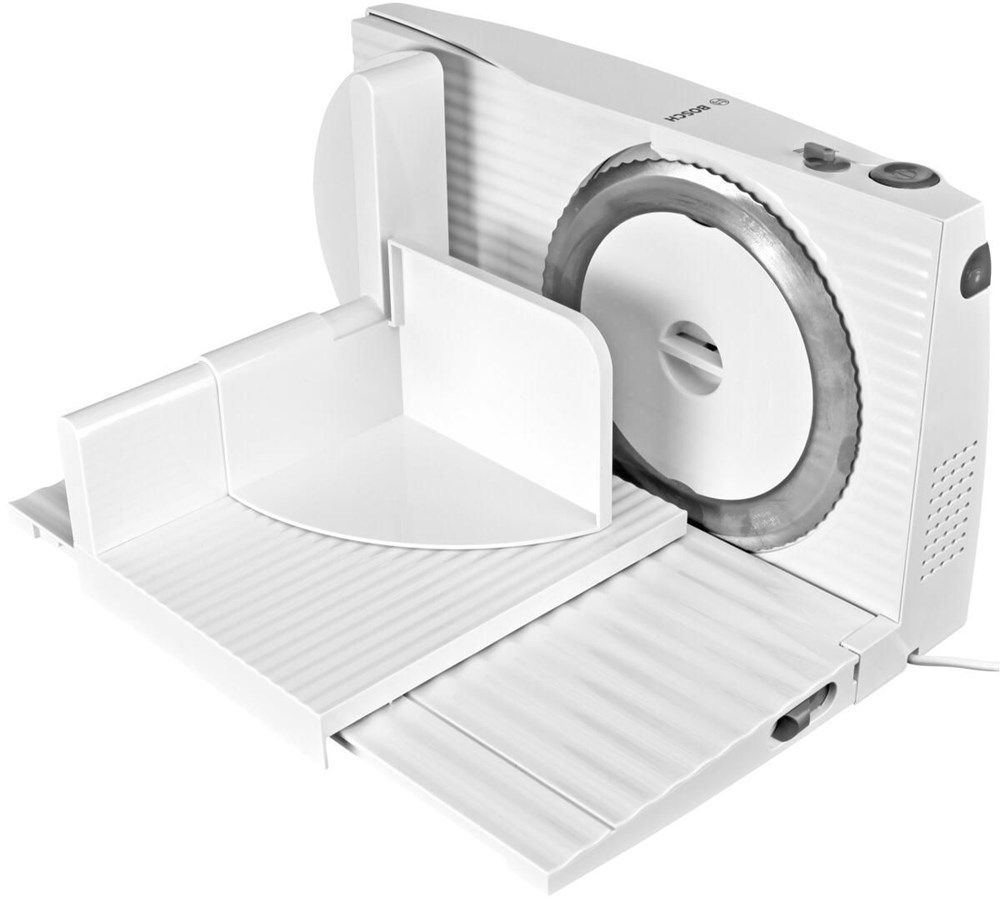
Slicer Bosch MAS 4601N
This 110W slicer can be operated in two modes, pulse and continuous. The presence of a pallet, a self-sharpening undulating knife and rotation adjustment, a low cost of 4200 rubles made this model the most popular.There is a safe turn on and a finger guard. The maximum slice thickness is 17 mm.
You can see the minimum slice thickness in the video:
- folding design;
- the presence of a pallet;
- several operating modes.
- low power;
- no tilt adjustment.
Zelmer 294.5
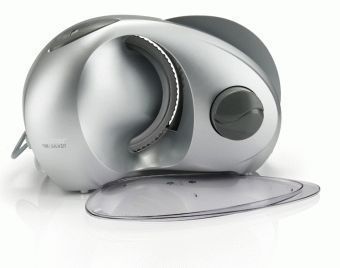
Slicer Zelmer 294.5
This slicer does not take up very much space in the kitchen. Made of plastic, the blade speed is not adjustable. Equipped with an additional tray and rubberized feet. Easy to use and clean. Self-sharpening blades. The average cost is 6,000 rubles.
- does not break off the ends of the pieces;
- high power;
- suitable for most products.
- high noise level.
Ritter E16
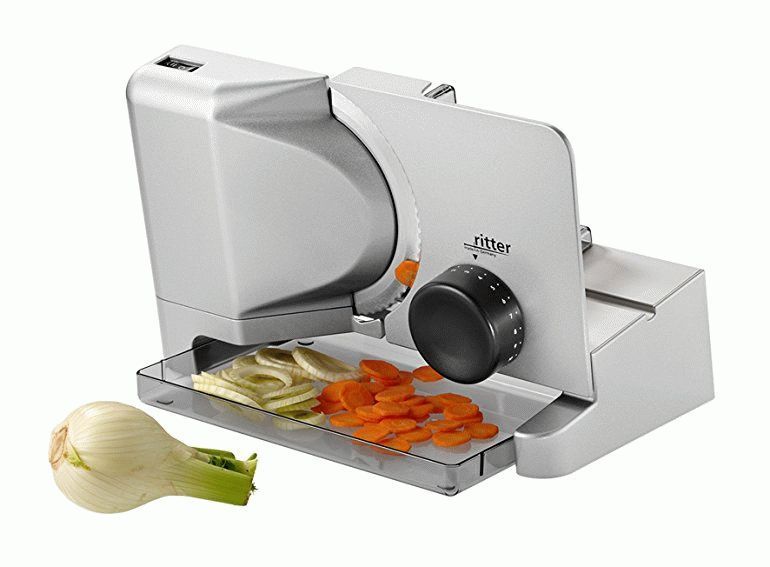
Slicer Ritter E16
The metal body of the slicer and the inclined work surface made this model the most popular choice. Self-sharpening undulating knife, maximum cutting thickness 20 mm, the presence of a tray for slices, two modes of operation - all this makes the slicer attractive. The average cost is 8000 rubles.
- availability of all possible functions;
- different operating modes;
- low price.
- heavy weight of the device.
Ariete 1789 Saladino 2.0 cordless

Slicer Ariete 1789 Saladino 2.0 cordless
It is the first cordless slicer to dispense ready-made slices directly into the jar. Powered by a battery that lasts for a long time. The set includes blades for cutting slices of various thicknesses and various types. Made from environmentally friendly durable plastic. Prices range from 3700 - 4000 rubles.
Slicer demonstration - in the video:
- portable device;
- small dimensions;
- easy to operate.
- long battery charging;
- unreliable battery;
- poor quality of slicing, jamming products.
Philips HR 1388/50
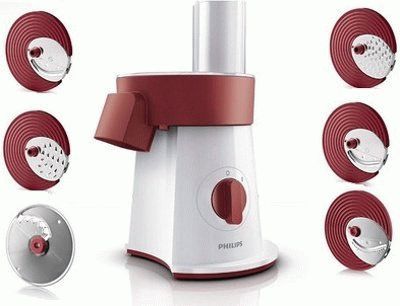
Slicer Philips HR 1388/50
A compact device that allows you not only to cut slices of various thicknesses, but also small and large pieces. There is no tray for accepting finished products, the device is too noisy, leaves a lot of dirt on the surface. The estimated cost is 4500 rubles.
Video review of the device:
- small size;
- protective blocking system;
- various types of slicing.
- no pallet for finished pieces;
- a lot of dirt;
- short power cord;
- does not cut many types of food very well.
Zelmer ZFS 0716SRU
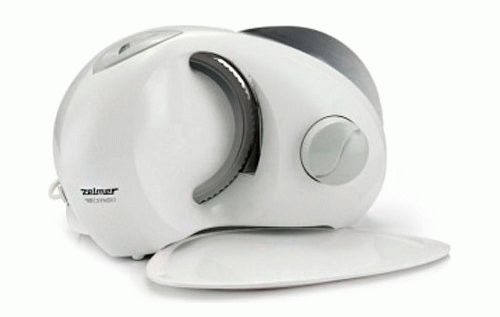
Slicer Zelmer ZFS 0716SRU
Attractive design and compactness of the device, combined with high power, put this slicer in the highest ratings. Plastic folding body, rubberized feet, wavy blade for cutting up to 15mm slices, safe to switch on. The price is 4200 rubles.
- high functionality;
- good workmanship;
- smooth adjustment of the thickness of the pieces.
- the presence of only one cutting speed;
- high noise level.
Bosch MAS 4000 W
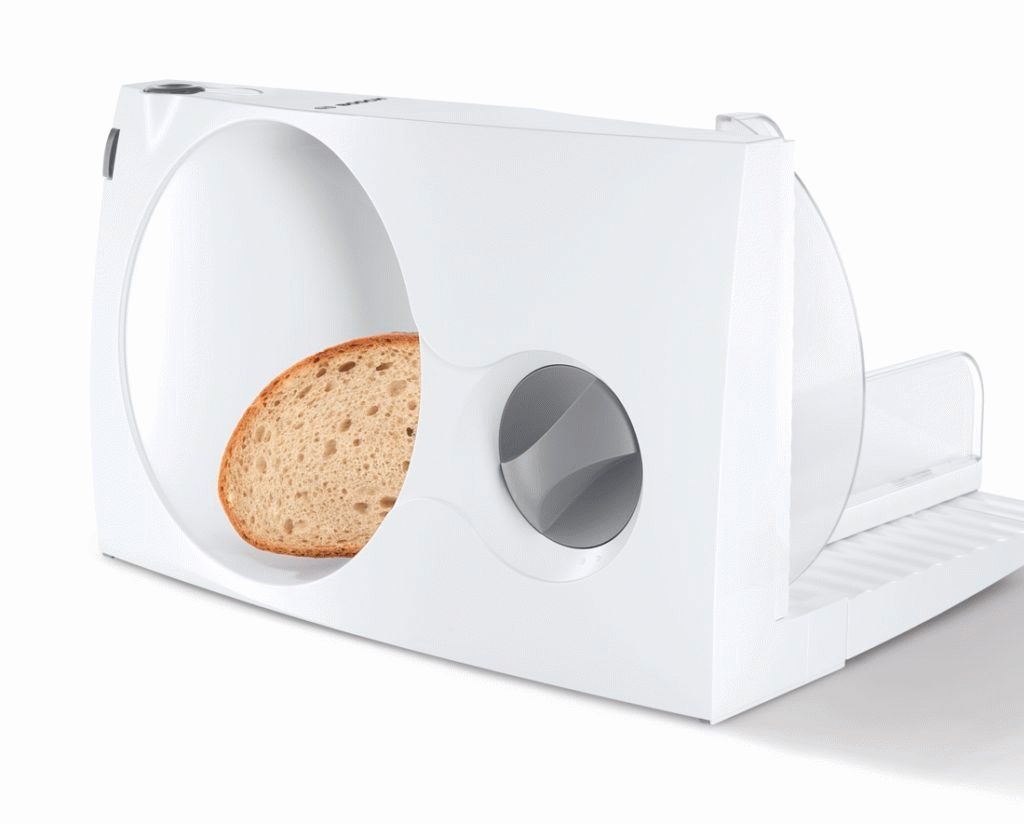
Slicer Bosch MAS 4000 W
This device is the best slicer at the moment. Low price, efficient use, all possible functions that allow you to cut all types of products made this model the most attractive for home use. Prices range from 2000 to 2500 rubles.
- cuts any food;
- self-sharpening knives;
- several operating modes;
- the presence of a slide for feeding products to the blade;
- fast speed of work.
- you must constantly hold the start button.
A few tips for caring for your slicer
- For easy cleaning, it is recommended to cut the fatty foods first, and the bread last to clean the blade. The device should be washed after each use.
- To prevent cheese from sticking to the blade, wipe the knife with a wet cloth.
- Meat products such as boiled pork should be placed with the fat on top, so it will be easier to cut them.
- Never try to cut bone-in or frozen foods.
- The body of the device should be wiped with a damp cloth, and the knives themselves should be washed in running water.
new entries
Categories
Useful
Popular articles
-

Top rating of the best and inexpensive scooters up to 50 cubic meters in 2020
Views: 97661 -

Rating of the best materials for noise insulation for an apartment in 2020
Views: 95022 -

Rating of cheap analogues of expensive drugs for flu and colds for 2020
Views: 91750 -

The best men's running shoes in 2020
Views: 87680 -

Top ranking of the best smartwatches 2020 - price-quality
Views: 85091 -

Best Complex Vitamins in 2020
Views: 84801 -

The best dye for gray hair - 2020 top ranking
Views: 82406 -

Rating of the best wood paints for interior use in 2020
Views: 77202 -

Ranking of the best action cameras from China in 2020
Views: 75269 -

Rating of the best spinning reels in 2020
Views: 74827 -

The most effective calcium supplements for adults and children in 2020
Views: 72462 -

Top rating of the best means for male potency in 2020 with a description
Views: 68296


